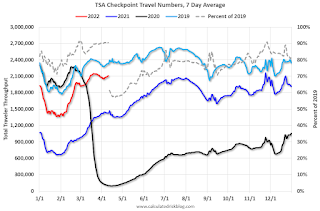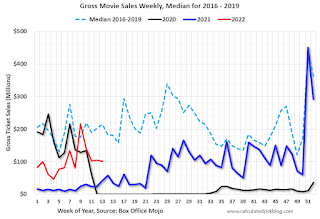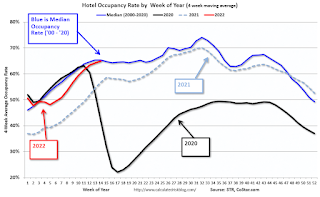by Calculated Risk on 4/12/2022 09:41:00 PM
Tuesday, April 12, 2022
Wednesday: PPI
Wednesday:
• At 7:00 AM ET, The Mortgage Bankers Association (MBA) will release the results for the mortgage purchase applications index.
• At 8:30 AM, The Producer Price Index for March from the BLS. The consensus is for a 1.1% increase in PPI, and a 0.5% increase in core PPI.
On COVID (focus on hospitalizations and deaths):
| COVID Metrics | ||||
|---|---|---|---|---|
| Now | Week Ago | Goal | ||
| Percent fully Vaccinated | 65.8% | --- | ≥70.0%1 | |
| Fully Vaccinated (millions) | 218.5 | --- | ≥2321 | |
| New Cases per Day3🚩 | 30,496 | 25,208 | ≤5,0002 | |
| Hospitalized3 | 9,704 | 10,807 | ≤3,0002 | |
| Deaths per Day3 | 507 | 540 | ≤502 | |
| 1 Minimum to achieve "herd immunity" (estimated between 70% and 85%). 2my goals to stop daily posts, 37-day average for Cases, Currently Hospitalized, and Deaths 🚩 Increasing 7-day average week-over-week for Cases, Hospitalized, and Deaths ✅ Goal met. | ||||
 Click on graph for larger image.
Click on graph for larger image.This graph shows the daily (columns) and 7-day average (line) of deaths reported.
2nd Look at Local Housing Markets in March
by Calculated Risk on 4/12/2022 03:02:00 PM
Today, in the Calculated Risk Real Estate Newsletter: 2nd Look at Local Housing Markets in March
A brief excerpt:
Here is a summary of active listings for these housing markets in March. Note: Inventory usually increases seasonally in March, so the month-over-month (MoM) increase is not surprising.There is much more in the article. You can subscribe at Calculated Risk Real Estate Newsletter
Inventory was up 9.3% in March MoM from February, and down 13.4% year-over-year (YoY). Inventory in about half of these markets was up YoY.
It appears inventory bottomed in February. Last month, these markets were down 23.3% YoY, so this is a significant change from February. This is the first step towards a more balanced market, but inventory levels are still very low.
Notes for all tables:
1) New additions to table in BOLD.
2) Northwest (Seattle) and Santa Clara (San Jose), Jacksonville, Source: Northeast Florida Association of REALTORS®
3) Totals do not include Atlanta or Denver (included in state totals).
Cleveland Fed: Median CPI increased 0.5% and Trimmed-mean CPI increased 0.5% in March
by Calculated Risk on 4/12/2022 11:09:00 AM
The Cleveland Fed released the median CPI and the trimmed-mean CPI this morning:
According to the Federal Reserve Bank of Cleveland, the median Consumer Price Index rose 0.5% in March. The 16% trimmed-mean Consumer Price Index also increased 0.5% in March. "The median CPI and 16% trimmed-mean CPI are measures of core inflation calculated by the Federal Reserve Bank of Cleveland based on data released in the Bureau of Labor Statistics’ (BLS) monthly CPI report".
Note: The Cleveland Fed released the median CPI details here: "Used Cars" were down 37% annualized in March, and this will likely show further declines in coming months. Motor fuel was up 648% annualized in March!
 Click on graph for larger image.
Click on graph for larger image.This graph shows the year-over-year change for these four key measures of inflation.
BLS: CPI increased 1.2% in March; Core CPI increased 0.3%
by Calculated Risk on 4/12/2022 08:33:00 AM
The Consumer Price Index for All Urban Consumers (CPI-U) increased 1.2 percent in March on a seasonally adjusted basis after rising 0.8 percent in February, the U.S. Bureau of Labor Statistics reported today. Over the last 12 months, the all items index increased 8.5 percent before seasonal adjustment.CPI was at expectations and core CPI was lower than expectations. I'll post a graph later today after the Cleveland Fed releases the median and trimmed-mean CPI.
Increases in the indexes for gasoline, shelter, and food were the largest contributors to the seasonally adjusted all items increase. The gasoline index rose 18.3 percent in March and accounted for over half of the all items monthly increase; other energy component indexes also increased. The food index rose 1.0 percent and the food at home index rose 1.5 percent.
The index for all items less food and energy rose 0.3 percent in March following a 0.5-percent increase the prior month. The shelter index was by far the biggest factor in the increase, with a broad set of other indexes also contributing, including those for airline fares, household furnishings and operations, medical care, and motor vehicle insurance. In contrast, the index for used cars and trucks fell 3.8 percent over the month.
The all items index continued to accelerate, rising 8.5 percent for the 12 months ending March, the largest 12-month increase since the period ending December 1981. The all items less food and energy index rose 6.5 percent, the largest 12-month change since the period ending August 1982. The energy index rose 32.0 percent over the last year, and the food index increased 8.8 percent, the largest 12-month increase since the period ending May 1981.
emphasis added
Monday, April 11, 2022
Tuesday: CPI
by Calculated Risk on 4/11/2022 08:16:00 PM
From Matthew Graham at Mortgage News Daily: MBS Live Recap: Running Out of Ways to Say "Higher Rates"
Market watchers are at risk of major desensitization when it comes to "rates continuing higher." For essentially all of 2022 apart from the onset of the Ukraine war, rates have moved one direction. Not only that, but the pace has been relatively unprecedented unless we compare it to some of the most horrific historical precedents. It seems that every time the market gives us a shred of hope that the outlook is moderating, the hope is quickly shredded and we're back to wondering how high rates will go before we see legitimate relief. Today ended up being just another day in that saga. [30 year fixed 5.25%]Tuesday:
emphasis added
• At 6:00 AM ET, NFIB Small Business Optimism Index for March.
• At 8:30 AM, The Consumer Price Index for March from the BLS. The consensus is for 1.2% increase in CPI (up 8.5% YoY) and a 0.5% increase in core CPI (up 6.6% YoY).
On COVID (focus on hospitalizations and deaths):
| COVID Metrics | ||||
|---|---|---|---|---|
| Now | Week Ago | Goal | ||
| Percent fully Vaccinated | 65.8% | --- | ≥70.0%1 | |
| Fully Vaccinated (millions) | 218.4 | --- | ≥2321 | |
| New Cases per Day3🚩 | 28,927 | 25,877 | ≤5,0002 | |
| Hospitalized3 | 9,240 | 11,064 | ≤3,0002 | |
| Deaths per Day3 | 500 | 582 | ≤502 | |
| 1 Minimum to achieve "herd immunity" (estimated between 70% and 85%). 2my goals to stop daily posts, 37-day average for Cases, Currently Hospitalized, and Deaths 🚩 Increasing 7-day average week-over-week for Cases, Hospitalized, and Deaths ✅ Goal met. | ||||
 Click on graph for larger image.
Click on graph for larger image.This graph shows the daily (columns) and 7-day average (line) of deaths reported.
Average daily deaths are the lowest since early August 2021.
Apartment Vacancy Rate Declined in Q1
by Calculated Risk on 4/11/2022 01:23:00 PM
Today, in the Calculated Risk Real Estate Newsletter: Apartment Vacancy Rate Declined in Q1
A brief excerpt:
Reis reported that the apartment vacancy rate was at 4.7% in Q1 2022, down from 4.8% in Q4, and down from a pandemic peak of 5.4% in both Q1 and Q2 2021.There is more in the article. You can subscribe at https://calculatedrisk.substack.com/
This graph shows the apartment vacancy rate starting in 1980. (Annual rate before 1999, quarterly starting in 1999). Note: Reis is just for large cities.Reis also reported the effective rents were up 2.5% in Q1 compared to Q4, and up 15.6% year-over-year. ...
Click on graph for larger image.
Effective rents declined significantly in the early stages of the pandemic, and even with the recent surge in rents, rents are only up 5.9% annualized over the last 2 years. So, a large portion of the rent increase over the last year was just making up for the previous declines.
For some cities, effective rents were up significantly more, especially in some cities like Albuquerque, Jacksonville and Phoenix. Other sunbelt areas like Las Vegas, Florida, and Southern California also saw huge rent increases.
Housing Inventory April 11th Update: Inventory up 2.3% Week-over-week; Up 8.3% from Seasonal Bottom
by Calculated Risk on 4/11/2022 09:32:00 AM
Tracking existing home inventory is very important in 2022.
Inventory usually declines in the winter, and then increases in the spring. Inventory bottomed seasonally at the beginning of March 2022 and is now up 8.3% since then.

This inventory graph is courtesy of Altos Research.
Last year inventory bottomed seasonally in April 2021 - very late in the year. This year, by this measure, inventory bottomed seasonally at the beginning of March.
Inventory is still very low. Compared to the same week in 2021, inventory is down 14.8% from 307 thousand, and compared to the same week in 2020, and inventory is down 65.1% from 749 thousand.
One of the keys will be to watch the year-over-year change each week to see if the declines are decreasing. Here is a table of the year-over-year change by week since the beginning of the year.
| Week Ending | YoY Change |
|---|---|
| 12/31/2021 | -30.0% |
| 1/7/2022 | -26.0% |
| 1/14/2022 | -28.6% |
| 1/21/2022 | -27.1% |
| 1/28/2022 | -25.9% |
| 2/4/2022 | -27.9% |
| 2/11/2022 | -27.5% |
| 2/18/2022 | -25.8% |
| 2/25/2022 | -24.9% |
| 3/4/2022 | -24.2% |
| 3/11/2022 | -21.7% |
| 3/18/2022 | -21.7% |
| 3/25/2022 | -19.0% |
| 4/1/2022 | -17.6% |
| 4/8/2022 | -14.8% |
Six High Frequency Indicators for the Economy
by Calculated Risk on 4/11/2022 09:03:00 AM
These indicators are mostly for travel and entertainment. It is interesting to watch these sectors recover as the pandemic subsides.
The TSA is providing daily travel numbers.
This data is as of April 10th.
 Click on graph for larger image.
Click on graph for larger image.This data shows the 7-day average of daily total traveler throughput from the TSA for 2019 (Light Blue), 2020 (Black), 2021 (Blue) and 2022 (Red).
The dashed line is the percent of 2019 for the seven-day average.
The 7-day average is down 9.5% from the same day in 2019 (90.5% of 2019). (Dashed line)
The second graph shows the 7-day average of the year-over-year change in diners as tabulated by OpenTable for the US and several selected cities.
 Thanks to OpenTable for providing this restaurant data:
Thanks to OpenTable for providing this restaurant data:This data is updated through April 9, 2022.
This data is "a sample of restaurants on the OpenTable network across all channels: online reservations, phone reservations, and walk-ins. For year-over-year comparisons by day, we compare to the same day of the week from the same week in the previous year."
Dining was mostly moving sideways but declined during the winter wave of COVID and is now increasing. The 7-day average for the US is down 1% compared to 2019.
 This data shows domestic box office for each week and the median for the years 2016 through 2019 (dashed light blue).
This data shows domestic box office for each week and the median for the years 2016 through 2019 (dashed light blue). Note that the data is usually noisy week-to-week and depends on when blockbusters are released.
Movie ticket sales were at $101 million last week, down about 52% from the median for the week.
 This graph shows the seasonal pattern for the hotel occupancy rate using the four-week average.
This graph shows the seasonal pattern for the hotel occupancy rate using the four-week average. The red line is for 2022, black is 2020, blue is the median, and dashed light blue is for 2021.
This data is through April 2nd. The occupancy rate was down 6.4% compared to the same week in 2019.
Notes: Y-axis doesn't start at zero to better show the seasonal change.
NOTE: This is the last Apple update. Apple will stop providing this data on April 14th.
 This data is through April 9th
This data is through April 9th The graph is the running 7-day average to remove the impact of weekends.
IMPORTANT: All data is relative to January 13, 2020. This data is NOT Seasonally Adjusted. People walk and drive more when the weather is nice, so I'm just using the transit data.
According to the Apple data directions requests, public transit in the 7-day average for the US is at 125% of the January 2020 level.
Here is some interesting data on New York subway usage (HT BR).
 This graph is from Todd W Schneider.
This graph is from Todd W Schneider. This data is through Friday, April 8th.
He notes: "Data updates weekly from the MTA’s public turnstile data, usually on Saturday mornings".
Sunday, April 10, 2022
Sunday Night Futures
by Calculated Risk on 4/10/2022 08:12:00 PM
Weekend:
• Schedule for Week of April 10, 2022
Monday:
• No major economic releases scheduled.
From CNBC: Pre-Market Data and Bloomberg futures S&P 500 are down 7 and DOW futures are down 55 (fair value).
Oil prices were down over the last week with WTI futures at $96.82 per barrel and Brent at $101.30 per barrel. A year ago, WTI was at $60 and Brent was at $62 - so WTI oil prices are up 60% year-over-year.
Here is a graph from Gasbuddy.com for nationwide gasoline prices. Nationally prices are at $4.10 per gallon. A year ago prices were at $2.86 per gallon, so gasoline prices are up $1.24 per gallon year-over-year.
Second Home Markets and FHFA Changes as of April 1st
by Calculated Risk on 4/10/2022 12:03:00 PM
Today, in the Calculated Risk Real Estate Newsletter: Second Home Markets and FHFA Changes as of April 1st
A brief excerpt:
Earlier this year the FHFA announced “Targeted Increases to Enterprise Pricing Framework”. Effective April 1st (just over a week ago), these higher fees applied to certain high balance loans, and to second home loans (for Fannie and Freddie). Excerpt:There is more in the article. You can subscribe at https://calculatedrisk.substack.com/... In April, upfront fees for high balance loans will increase between 0.25 percent and 0.75 percent, tiered by loan-to-value ratio. Fannie Mae and Freddie Mac refer to these mortgages as high balance loans and super conforming loans, respectively. For second home loans, upfront fees will increase between 1.125 percent and 3.875 percent, tiered by loan-to-value ratio.South Lake Tahoe: Second Home Market
emphasis added
...
Click on graph for larger image.
With the pandemic, there was a surge in second home buying. One of the second home markets I’ve been tracking is South Lake Tahoe.The following graph is for single family homes in South Lake Tahoe since 2004 through March 2022, and shows inventory (blue), and the year-over-year (YoY) change in the median price (12-month average).Note: The median price is distorted by the mix, but this is the available data.
...
This will be interesting to watch over the next several months, but so far there isn't any evidence of a second home slowdown in these numbers.



